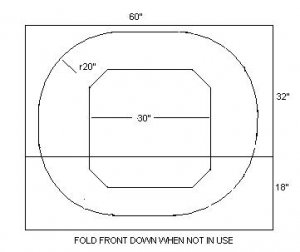I just made some extra space in a spare room in my apartment. The biggest layout that will fit in the space is 32" x 60". I figure I can get away with using some atlas 15" radius snap track, but I have a couple of questions. I just picked up one of those Bachmann EZ command DCC kits with the loco (GP-50) and some short rolling stock. It's time to get my feet wet with DCC. All have the EZ mate/ kadee couplers. First, will this loco be able to make the radius? and two, will the couplers stay together?
I really dont want to make a switching only shelf layout, I'm a continuous running kind of guy. I know there won't be much room to spare on the outside of the track, so I plan to make a "guardrail" of sorts out of crown moulding to keep any funny business from happening. I currently have a 2x9 continuous running HO layout in another room, but I'm getting tired of having to heavily modify stuff to run on it, not to mention it looks bizarre doing it! If this is not possible, I may have to move to a 2x8 switching layout, in that case, post some plans if you have any.
I'm tired of N scale....I'm sorry, I tried it and it just wasn't for me. I don't know how my grandpa spent 20 years with it.
Thanks for the advice, you guys sure have helped out in the past!
I really dont want to make a switching only shelf layout, I'm a continuous running kind of guy. I know there won't be much room to spare on the outside of the track, so I plan to make a "guardrail" of sorts out of crown moulding to keep any funny business from happening. I currently have a 2x9 continuous running HO layout in another room, but I'm getting tired of having to heavily modify stuff to run on it, not to mention it looks bizarre doing it! If this is not possible, I may have to move to a 2x8 switching layout, in that case, post some plans if you have any.
I'm tired of N scale....I'm sorry, I tried it and it just wasn't for me. I don't know how my grandpa spent 20 years with it.
Thanks for the advice, you guys sure have helped out in the past!


